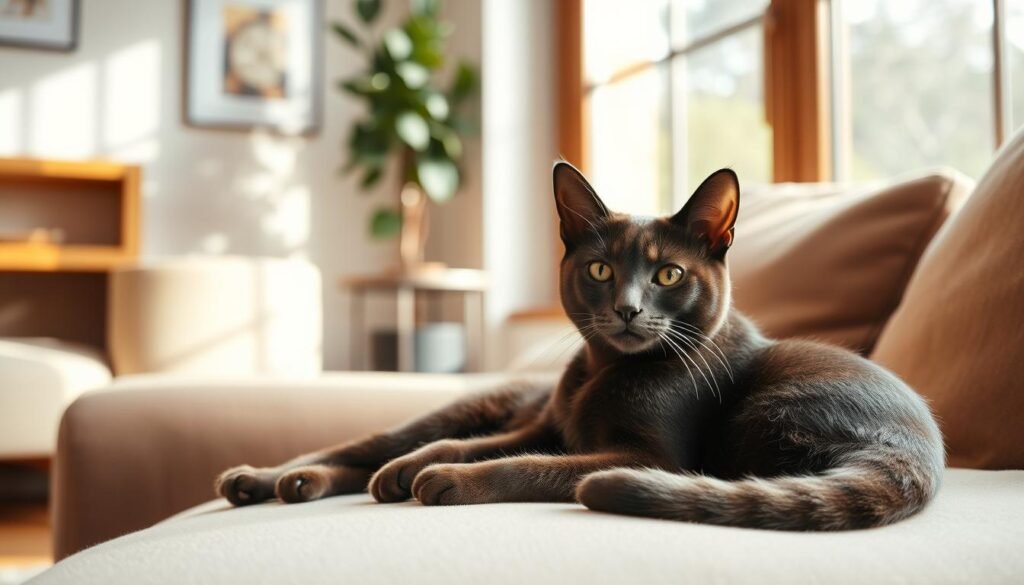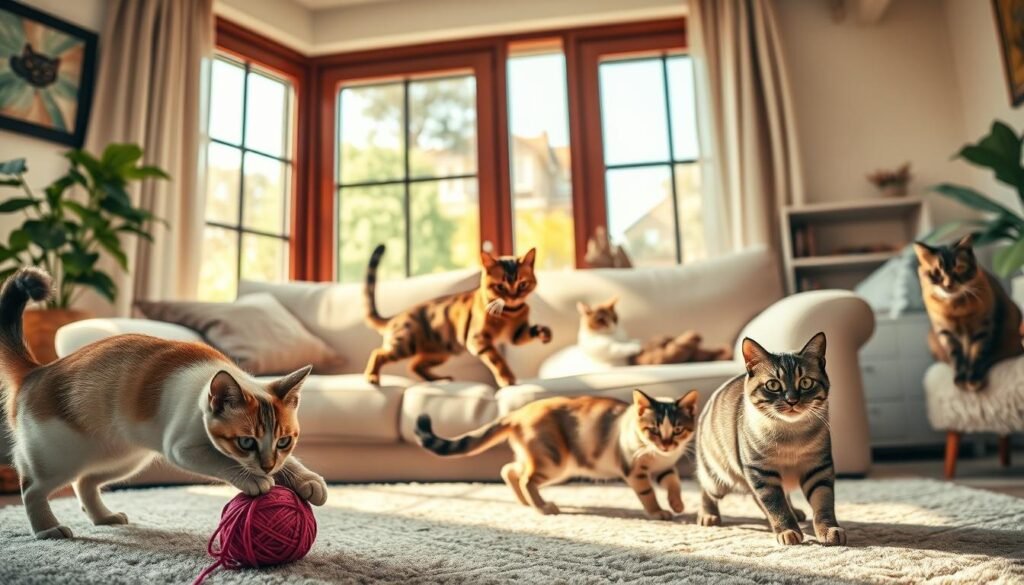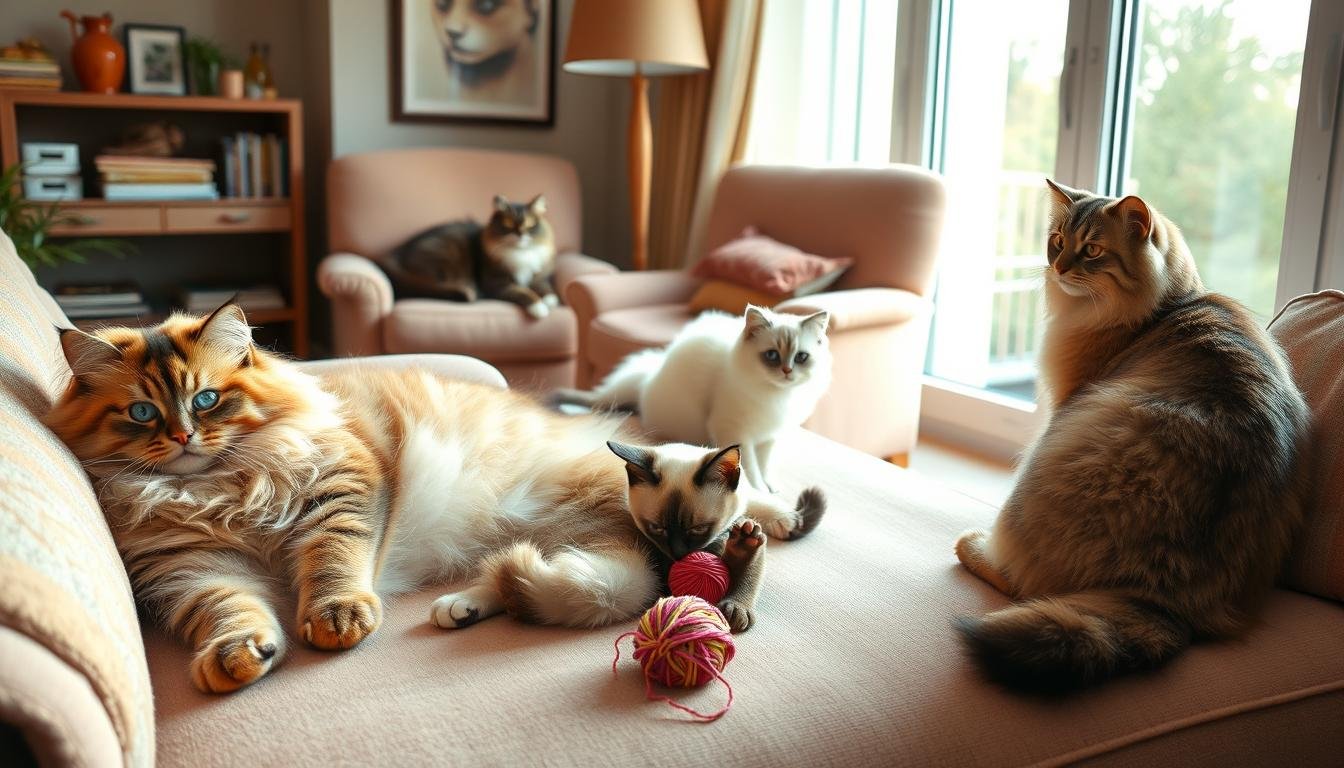Popular Cat Breeds: Which Ones Are Loved the Most?
As a cat owner, you might think cats are always alone and don’t like people or other animals. But, many beloved cats are friendly and loving, just like dogs!
Some popular cat breeds are more loved than others. It’s not just their looks. Their personalities and how they act make them special. In this article, we’ll look at the most loved cat breeds and why they’re so unique.
Knowing what makes these breeds popular can help you choose the right one for your family.
Table of Contents
What Makes Certain Cat Breeds More Popular Than Others
Some cat breeds capture our hearts with their unique traits. Their popularity comes from both their personality and looks.
Personality Traits That Win Cat Lovers’ Hearts
A cat’s personality is shaped by its genes and early life. Friendly cat breeds are often the favorites because they are loving and outgoing. They bond well with their owners, making them very popular.
Some breeds are playful but gentle, perfect for families or new cat owners. A cat’s personality is key to its popularity. Many want a cat that is both loving and easy to get along with.
Physical Characteristics and Their Appeal
Physical traits also matter a lot in cat breeds’ popularity. A cat’s look, including its fur, color, and body shape, affects its appeal. Top cat breeds often have special features that make them stand out.
For example, some cats are loved for their long, soft fur. Others are admired for their short, sleek coats. This variety lets people pick a cat that matches their style and life.
| Breed | Personality Trait | Physical Characteristic |
|---|---|---|
| Ragdoll | Affectionate | Soft, silky coat |
| Maine Coon | Playful, friendly | Large size, distinctive shaggy coat |
| British Shorthair | Easygoing | Sturdy build, short dense coat |
The Nicest Cat Breeds for First-Time Owners
If you’re new to owning a cat, you want a breed that’s friendly and easy to care for. The right cat breed can greatly improve your experience as a pet owner. Some breeds are known for being very affectionate and simple to care for, making them great for beginners.
Ragdoll: The Gentle Giant
The Ragdoll cat breed was developed in the 1960s by Ann Baker. They are known for being calm and going limp when held. This makes them perfect for those who want a relaxed pet.
Temperament and Personality
Ragdolls are known for their passive behavior and love for people. They act like dogs, following their owners and loving to be held.
Care Requirements
Ragdolls have a soft coat that needs regular grooming to avoid matting. They are generally healthy but can have health issues like hypertrophic cardiomyopathy.
Maine Coon: Friendly and Sociable
Maine Coon cats are big and have a distinctive shaggy coat. They are very friendly and love to be around people.
Temperament and Personality
Maine Coons are smart and fun, making them great for families. They get along well with kids and other pets if they are socialized properly.
Care Requirements
Their thick coat needs regular brushing, especially when they shed. Maine Coons are usually healthy but can get hip dysplasia or spinal muscular atrophy.
British Shorthair: Easygoing Companions
The British Shorthair is sturdy with a broad face and short coat. They are easygoing and love people.
Temperament and Personality
British Shorthairs are laid-back and not demanding. They are quiet and good for apartment living because they don’t meow much.
Care Requirements
Their short coat needs little grooming, making them easy to care for. But, they can get fat if they don’t get enough exercise and eat right.
https://www.youtube.com/watch?v=vDOHOvr7k-s
| Breed | Temperament | Grooming Needs |
|---|---|---|
| Ragdoll | Affectionate, laid-back | Regular grooming |
| Maine Coon | Intelligent, playful | High maintenance coat |
| British Shorthair | Easygoing, quiet | Low maintenance coat |
Most Affectionate Cat Breeds for Families
Affectionate cat breeds can be a wonderful addition to any family. They provide companionship and love. If you’re looking for a feline friend, consider these breeds.
Siamese: Vocal and Devoted
The Siamese breed is known for its striking appearance and affectionate personality. Siamese cats are easy to recognize with their vivid blue eyes, dark faces and paws, and light-colored bodies. Their unique coloring comes from a form of partial albinism.
Temperament and Personality
Siamese cats are vocal and demanding of attention. They are often described as “talkative” because they communicate their needs and wants through various vocalizations. They are highly social and form strong bonds with their family members.
Care Requirements
To keep your Siamese cat happy, provide regular interaction and playtime. They thrive on attention and can become destructive if left alone for too long without stimulation.
Abyssinian: Playful and People-Oriented
Abyssinians are known for their playful and energetic nature. They are highly interactive and love being around people.
Temperament and Personality
Abyssinian cats are curious and playful, often enjoying games that challenge their agility and intelligence. They are people-oriented and enjoy being part of family activities.
Care Requirements
To care for an Abyssinian, provide plenty of toys and engage in regular play. They require stimulation to prevent boredom and destructive behavior.
Persian: Calm and Cuddly
Persian cats are renowned for their calm demeanor and beautiful long coats. They are a popular choice for families seeking a gentle pet.
Temperament and Personality
Persians are known for being calm and laid-back, making them a great choice for families with children. They are affectionate but not overly demanding.
Care Requirements
Persian cats require regular grooming to prevent matting and tangling of their fur. Daily brushing is essential to keep their coat in good condition.
Choosing the right cat breed involves considering your family’s lifestyle and what you’re looking for in a pet. These breeds are known for their affectionate nature, making them great companions.
Low-Maintenance Popular Cat Breeds
Cat lovers who prefer a more laid-back pet experience often turn to low-maintenance breeds. These cats are perfect for busy owners or those who are new to cat ownership. They offer the companionship and affection that cat lovers crave without the high demands of grooming or exercise. In this section, we’ll explore three popular breeds known for their ease of care: the American Shorthair, Russian Blue, and Domestic Shorthair.
American Shorthair: The Classic Companion
The American Shorthair is a beloved breed known for its sturdy build and short, dense coat. It comes in a wide variety of colors and patterns, including white, black, cream, and tortoiseshell.
Temperament and Personality
American Shorthairs are known for their friendly, outgoing personalities. They are easy-going and get along well with children and other pets, making them an excellent choice for families.
Care Requirements
Their short coat requires minimal grooming, making them a low-maintenance choice. They are generally healthy, but regular veterinary check-ups are still necessary.
Russian Blue: Independent Yet Affectionate
The Russian Blue is a sleek and agile breed with a thick, plush coat. It is known for its blue-gray color.
Temperament and Personality
Russian Blues are known for their reserved nature, but they are also very affectionate with their owners. They are intelligent and playful but not overly demanding.
Care Requirements
Their thick coat requires regular grooming to prevent matting, but they are generally easy to care for. They are also known for their good health, with a lifespan of up to 20 years.
Domestic Shorthair: America’s Beloved Mixed Breed
The Domestic Shorthair is not a specific breed but a generic term for mixed-breed cats. They are found in a wide range of coat lengths, colors, and patterns.
Temperament and Personality
Domestic Shorthairs are known for their adaptability and friendly nature. They are often very affectionate and get along well with both children and other pets.
Care Requirements
Their care requirements vary depending on their coat type, but many have short coats that require minimal grooming. Regular veterinary care and a balanced diet are essential for their health.
Here’s a comparison of the three breeds:
| Breed | Coat Type | Grooming Needs | Temperament |
|---|---|---|---|
| American Shorthair | Short, dense | Low | Friendly, outgoing |
| Russian Blue | Thick, plush | Moderate | Reserved, affectionate |
| Domestic Shorthair | Varies | Varies | Adaptable, friendly |

Hypoallergenic Cat Breeds That Win Hearts
For those with allergies but wanting a cat, hypoallergenic breeds are a good option. They don’t eliminate all allergens but have less than others. The Siberian, Balinese, and Devon Rex are top picks for allergy sufferers. Each has special traits that make them stand out.
Siberian: Surprisingly Allergy-Friendly
Siberian cats are smart and fun, making great friends. They have a thick coat but less Fel d 1 protein in their saliva and skin. This is the main cause of cat allergies.
Temperament and Personality
Siberians are friendly and love people. They’re smart and can learn tricks or play fetch.
Care Requirements
They have a thick coat but are easy to care for. Regular grooming is needed to avoid matting. They don’t need to be bathed often.
Balinese: Less Allergenic Siamese Relatives
Balinese cats look like Siamese but have longer fur. They are known for their beauty and loving nature.
Temperament and Personality
Balinese cats talk a lot and want attention. They love being part of family life.
Care Requirements
Their fur needs regular grooming to prevent tangles. They are generally healthy but can have some genetic issues.
Devon Rex: The Hypoallergenic Pixie
The Devon Rex has a unique, curly coat. They are playful, curious, and a bit mischievous.
Temperament and Personality
Devon Rex cats are very active and love to explore. They are smart and fun to watch.
Care Requirements
Their fur needs occasional grooming to avoid oil buildup. They are strong but sensitive to cold or hot weather.
| Breed | Allergy-Friendliness | Grooming Needs | Personality |
|---|---|---|---|
| Siberian | Low allergen levels | Regular grooming | Friendly, playful |
| Balinese | Less allergenic | Regular grooming | Vocal, social |
| Devon Rex | Hypoallergenic | Occasional grooming | Curious, playful |
Choosing a hypoallergenic cat breed can be rewarding. These breeds, like the sweetest cat breeds, offer friendship without allergies. They’re perfect for many families.
Most Playful and Energetic Cat Breeds
Cats come in many types, some being very playful and full of energy. If you want a cat that matches your lively lifestyle, you’re in the right spot. Let’s look at some of the most playful and energetic cat breeds that will surely win your heart.
Bengal: The Miniature Leopard
Bengal cats are full of energy and love to play, making them great friends. They are a mix of domestic cats and the Asian leopard cat.
Temperament and Personality
Bengals are very energetic and smart. They need lots of fun and activities to stay happy. They love to jump, climb, and explore.
Care Requirements
To keep a Bengal cat happy, you need to give them lots of exercise and fun activities. Playing with toys and setting up a cat agility course are good ideas. They also need regular grooming to keep their coat healthy.
Cornish Rex: The Playful Acrobat
The Cornish Rex is known for its playful and energetic nature. Their unique, wavy coat is just the start of what makes them special.
Temperament and Personality
Cornish Rex cats are curious and playful. They are very active and love to be around people. Their smartness and energy make them a lot of fun.
Care Requirements
These cats need lots of play to stay happy and active. They also like a warm place to live, as their thin coat doesn’t keep them warm.
Japanese Bobtail: Energetic and Intelligent
The Japanese Bobtail is known for its short tail and playful, energetic nature.
Temperament and Personality
Japanese Bobtails are smart and active, often acting like dogs because they love to play fetch and go for walks. They are very social and bond strongly with their owners.
Care Requirements
To care for a Japanese Bobtail, you need to give them lots of exercise and fun activities. They love to play and interact, so be ready to spend time with them.
In conclusion, if you’re looking for a playful, energetic, and friendly cat, consider the Bengal, Cornish Rex, or Japanese Bobtail. Each breed has unique qualities that make them great pets for the right owner.

Cat Breeds Known for Their Unique Appearances
If you love cats with special features, you’re in good company. Many cat lovers are drawn to breeds with unique looks. Let’s look at three such breeds: the Scottish Fold, Sphynx, and Munchkin.
Scottish Fold: Distinctive Folded Ears
The Scottish Fold is known for its folded ears, thanks to a natural genetic mutation. This breed is not just about its looks. It’s also friendly and outgoing.
Temperament and Personality
Scottish Folds are very affectionate and love being around people. They get along well with kids and other pets. This makes them a great fit for many families.
Care Requirements
To keep your Scottish Fold healthy, regular grooming is key. They also need a balanced diet and regular vet visits.
Sphynx: The Hairless Wonder
The Sphynx is famous for being hairless. Despite this, they are very affectionate and playful.
Temperament and Personality
Sphynx cats are very social and love being around people. They are often called Velcro cats because they stick close to their owners.
Care Requirements
Because they have no fur, Sphynx cats need regular skin care. This includes bathing and protecting their skin from the sun.
Munchkin: Short-Legged Charmers
Munchkin cats have short legs due to a genetic mutation. Despite their short legs, they are very agile and playful.
Temperament and Personality
Munchkins are friendly, outgoing, and love to play. They are great with kids and other pets, making them a wonderful family pet.
Care Requirements
Munchkins need regular exercise and a balanced diet to stay healthy. Their short legs don’t stop them from playing, but they might need some adjustments to their environment to avoid injury.
Here’s a quick summary of these breeds’ unique features and care needs:
| Breed | Unique Feature | Care Requirements |
|---|---|---|
| Scottish Fold | folded ears> | Regular grooming, balanced diet |
| Sphynx | Hairlessness | Regular skin care, sun protection |
| Munchkin | Short Legs | Regular exercise, safe environment |
Special Care Tips for the Most Popular Cat Breeds
To keep your cat healthy and happy, it’s key to know their special care needs. Each cat breed has its own unique traits and needs. Understanding these can help your cat live a long, healthy life.
Grooming Requirements by Breed Type
Different cat breeds need different grooming. Long-haired cats like the Persian and Maine Coon need regular brushing. This prevents their fur from matting.
Short-haired cats, such as the British Shorthair and American Shorthair, groom less often. But they still need nail trimming and ear cleaning regularly.
A simple grooming table can help you understand the needs of different breeds:
| Breed | Grooming Needs | Frequency |
|---|---|---|
| Persian | Brushing, Bathing | Daily, Weekly |
| Maine Coon | Brushing, Nail Trimming | Daily, Monthly |
| British Shorthair | Nail Trimming, Ear Cleaning | Monthly |
Exercise and Enrichment Needs
Exercise and mental stimulation are vital for your cat’s well-being. Energetic breeds like the Abyssinian and Bengal need lots of playtime. They also need interactive toys to keep them engaged.
More relaxed breeds, such as the Ragdoll, don’t need as much exercise. But they still need regular play to stay physically and mentally healthy.
Common Health Concerns in Popular Breeds
Some health issues are more common in certain cat breeds. For example, Persian cats often have respiratory problems. Maine Coons can be at risk for heart disease.
Knowing these health risks lets you take steps to care for your cat. This ensures they get the best care for their breed’s needs.
How to Choose the Right Popular Cat Breed for Your Lifestyle
Finding the perfect cat breed for your home is key to happiness. It’s important to match your lifestyle and preferences with the right cat. This ensures a loving and harmonious relationship with your new pet.
Assessing Your Living Situation
Your home size affects the best cat breed for you. For example, a small apartment is perfect for a friendly cat breed like the British Shorthair. They need less space and exercise. But, if you have a big house, you might prefer more active breeds that love to explore.
Considering Time Commitment and Care Requirements
Each cat breed has its own care needs. Some, like the Siamese, are very talkative and need lots of attention. They’re not ideal for busy owners who are away a lot. On the other hand, independent breeds like the Russian Blue are great for those with less time.
Where to Adopt Popular Cat Breeds
After picking a breed, find a good place to adopt from. Look at local shelters, rescue groups, or breed registries. These places help you find your cat and give a loving home to a cat in need.
Conclusion: Finding Your Perfect Feline Companion
Exploring popular cat breeds shows each has its own charm. From the gentle Ragdoll to the playful Bengal, there’s a cat for every lifestyle. These breeds offer a mix of affection, playfulness, and companionship.
When picking a cat, think about your living situation and how much time you can commit. Also, consider the care needs of different breeds. This way, you can choose the perfect cat for you and enjoy a great friendship.
Looking for a laid-back friend or an active playmate? The right cat breed is waiting for you. Spend time learning about the nicest cat breeds. This will help you find the perfect feline companion.

